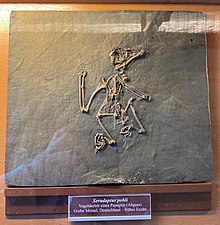Halcyornithidae
| Halcyornithidae Temporal range:
| |
|---|---|

| |
| Cast of the holotype of Serudaptus, a halcyornithid, at the Natural History Museum of Vienna | |
| Scientific classification | |
| Domain: | Eukaryota |
| Kingdom: | Animalia |
| Phylum: | Chordata |
| Class: | Aves |
| Clade: | Eufalconimorphae |
| Family: | †Halcyornithidae Harrison & Walker, 1972 |
| Genera | |
| |
| Synonyms | |
|
Pseudasturidae(Mayr, 2002) | |
Halcyornithidaeis an extinct family oftelluravianbirds thought to be related to thePsittaciformes(parrots),Passeriformes(songbirds), and to the extinctMesselasturidae.Halcyornithids have been found in various Eocene formations inEuropeandNorth America.Widespread and diverse in theEarly Eoceneof North America and Europe, halcyornithids are not found in locales later than theMiddle Eocene.Halcyornithids were small, arboreal birds withzygodactylfeet, with two toes facing forwards and two facing back, a trait shared with other tree-dwelling families of Eocene birds like theZygodactylidaeand the messelasturids. The skull of halcyornithids features a ridge of bone above the eye called the supraorbital process, similar to birds of prey.[1][2] The relationships of the halcyornithids to other birds remain uncertain. Halcyornithids have been proposed as relatives toowlsand as a lineage closer to parrots than to songbirds. Most recently, halcyornithids have been identified as thesister groupof thecladeincluding parrots and songbirds. It is also possible that Halcyornithidae isparaphyleticwith respect to theMesselasturidae.[1]
Description
[edit]Halcyornithids are recognisable by details of the skull and limbs. Thetarsometatarsus,the lowermost bone of the leg, is short and shaped like those of parrots. The distal end of the tarsometatarsus has a projection of bone that supports the fourth toe, which is reversed and faces backwards.[3]Unlike in parrots, however, this projection is not separated by a groove from the rest of the trochlea supporting the other toes. The third toe is strongly built, more so than the others. The humerus is long and slender, and thecoracoidis shaped like that found in owls, and has aforamenfor the supracoracoideus nerve.[2]
The skulls of halcyornithids bear a prominent shelf of bone above the upper margin of the eye, the supraorbital process, comparable to that present in falcons and other birds of prey. One proposed function of the supraorbital process is mechanical protection of the eyeball from injury, for example, such as might be caused by struggling prey animals being killed with the beak.[1]The morphology of the head is overall similar to that of messelasturids, but in halcyornithids, themandibleis proportionally much longer.[4]
Distribution
[edit]A high diversity of halcyornithid birds is found in the EoceneLondon ClayinEngland,from sites nearWalton-on-the-Nazeand theIsle of Sheppey.Of the specimens collected from that location, almost none do not bear minor morphological dissimilarities to others, indicating that there were likely many species living in the area, comprising anadaptive radiation.[1]Halcyornithids are also known from theMessel Pit,inGermany,where specimens likewise exhibit diversity.[5][1]Other halcyornithid-bearing sites in Europe include theGeisel Valleyof Germany, which has produced the most recent evidence of halcyornithids, ofMiddle Eoceneage, theFur FormationinDenmark,and the Egem inBelgium.From theMenatinFranceis a skeleton tentatively believed to be a halcyornithid, which may also be ofPaleoceneage. In theNorth America,halcyornithids have been found in theGreen River Formationof the US state ofUtahas well as theNanjemoy Formationof the state ofVirginia.[1]
Classification
[edit]Placement of the Halcyornithidae after Ksepka et. al, 2019.[6]
| |||||||||||||||||||||||||||||||||||||
Internal classification of the Halcyornithidae and Messelasturidae after Mayr & Kitchener, 2022.[7]
References
[edit]- ^abcdefMayr, Gerald;Kitchener, Andrew C. (2023-07-17)."The Halcyornithidae from the early Eocene London Clay of Walton-on-the-Naze (Essex, UK): A species complex of Paleogene arboreal birds".Geobios.doi:10.1016/j.geobios.2023.06.003.ISSN0016-6995.S2CID259969084.
- ^abMayr, Gerald (2022).Paleogene fossil birds.Fascinating life sciences (2nd ed.). Cham: Springer.ISBN978-3-030-87644-9.
- ^Dyke, Gareth (2001)."Fossil pseudasturid birds (Aves, Pseudasturidae) from London Clay".Bulletin of the Natural History Museum, Geology Series.57:1–4 – via Biodiversity Heritage Library.
- ^Mayr, G. (2000-01-01)."New or previously unrecorded avian taxa from the Middle Eocene of Messel (Hessen, Germany)".Fossil Record.3(1): 207–219.doi:10.1002/mmng.20000030110.ISSN2193-0066.
- ^Mayr, Gerald (1998-10-01)."A new family of Eocene zygodactyl birds".Senckenbergiana Lethaea.78(1): 199–209.doi:10.1007/BF03042769.ISSN0037-2110.S2CID62901085.
- ^Ksepka, Daniel T.; Grande, Lance; Mayr, Gerald (2019-02-18)."Oldest Finch-Beaked Birds Reveal Parallel Ecological Radiations in the Earliest Evolution of Passerines".Current Biology.29(4): 657–663.e1.Bibcode:2019CBio...29E.657K.doi:10.1016/j.cub.2018.12.040.ISSN0960-9822.PMID30744971.
- ^Mayr, Gerald; Kitchener, Andrew C. (2022-11-14)."Psittacopedids and zygodactylids: The diverse and species-rich psittacopasserine birds from the early Eocene London Clay of Walton-on-the-Naze (Essex, UK)".Historical Biology.35(12): 2372–2395.doi:10.1080/08912963.2022.2141629.ISSN0891-2963.
